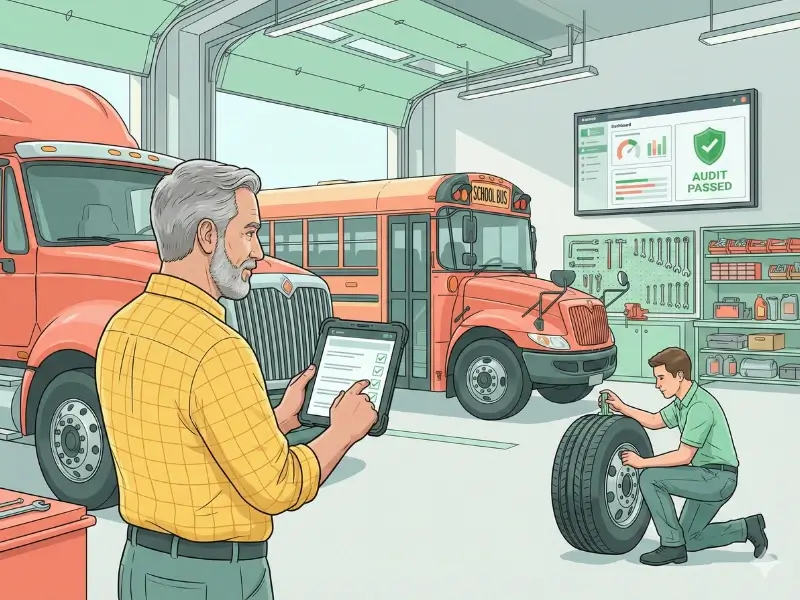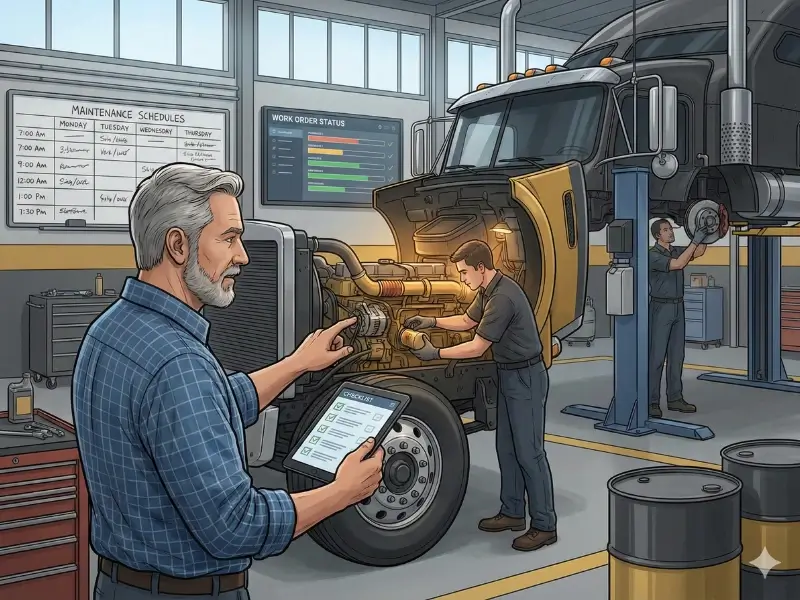Key Takeaways
Vehicle inspections are the heartbeat of effective fleet management. They're not just a compliance checkbox—they’re a powerful window into the operational health of your fleet. But one question continues to frustrate many fleet managers: how long should a vehicle inspection actually take?
Is there a perfect duration? Can inspections be too fast—or even too slow? And most importantly, how can you optimize the process without sacrificing safety or efficiency?
In this article, we explore the real factors that affect inspection time, why speed alone doesn’t guarantee quality, and how digital tools can revolutionize the way your fleet handles inspections.
Why Vehicle Inspections Matter More Than You Think
Whether you’re running a delivery fleet or managing heavy-duty equipment, vehicle inspections are your first line of defense against downtime. A well-conducted inspection helps detect:
- Brake or tyre wear
- Engine issues
- Safety risks (e.g., broken lights, cracked windshields)
- Signs of prior accidents or damage
More importantly, regular inspections help prevent unexpected breakdowns, keeping your vehicles road-ready and your operations on schedule.
So, How Long Should a Vehicle Inspection Take?
Here’s the honest answer: it depends. There’s no one-size-fits-all rule. Factors like the type of vehicle, the complexity of the checklist, the inspector’s experience, and even the method of inspection (manual vs. digital) all influence the time taken.
Traditional Inspections
In a traditional setup, a vehicle inspection might take anywhere from 30 minutes to a couple of hours. But this doesn’t include:
- Scheduling delays
- Travel time (if inspectors visit the vehicle)
- Manual report processing and data entry
These additional steps can stretch the total turnaround to days or even weeks, especially in busy or remote locations.
Digital Inspections
Modern digital inspection tools can cut that time down to mere minutes. Using mobile apps and AI-powered assessments, drivers or operators can capture key inspection data quickly and send it directly to fleet managers in real time.
The Risks of Going Too Fast
Speed sounds great—until it starts causing problems.
A common issue in fleet management is “pencil whipping”—where inspections are rushed or faked just to get them done. Here’s how to know if your inspections are moving too quickly:
- Vehicles frequently break down despite regular inspections.
- Failed items are rarely, if ever, reported.
- You notice the same inspection durations across all vehicles and drivers (a red flag for copy-paste work).
Missed issues = higher repair costs and more vehicle downtime. What seems like a quick win today can turn into a costly failure tomorrow.
And the Problem with Going Too Slow
On the flip side, overly slow inspections create their own headaches.
If your team is bogged down with long paper forms, repetitive checks, or inefficient reporting methods, you’re wasting precious hours each day. Worse, the extra time doesn’t always mean more accuracy—just more room for human error and paperwork backlogs.
A slow inspection might look like this:
- Driver fills out a long checklist on paper.
- Paperwork is handed to the admin team.
- Data is re-entered into a computer.
- The report is stored in multiple locations manually.
- You find out about a failed item hours—or even days—later.
In the meantime, the faulty vehicle might still be out on the road.
The Hidden Costs of Inefficient Inspections
Whether fast or slow, poorly managed inspections cost money in more ways than one:
- Increased downtime due to undetected issues.
- Repair expenses from lack of early detection.
- Compliance risks during audits or road checks.
- Reduced driver satisfaction due to tedious or frustrating processes.
- Wasted man-hours on manual tasks like data entry and form organization.
Download our free Daily Vehicle Inspection Checklist
Striking the Right Balance: Tips to Improve Your Inspection Process

Improving vehicle inspection efficiency doesn’t mean choosing between speed and thoroughness. The key is to design a process that’s both fast and reliable. Here’s how:
Digitise Your Inspection Process
Switch from paper-based inspections to digital forms using fleet management software. Platforms like Simply Fleet offer mobile-friendly inspection apps that:
- Let drivers complete checklists from their phone or tablet
- Automatically send inspection results to managers
- Create instant work orders for failed items
- Store all reports securely in one place for audits
Result: Faster, more accurate inspections with zero paperwork delays.
Simplify and Audit Your Inspection Forms
Are your forms too bulky? If drivers are spending more time filling out unnecessary fields than inspecting the vehicle itself, that’s a problem.
- Review your inspection checklist: Include only essential items.
- Group questions logically by vehicle section (engine, tires, bodywork).
- Eliminate repetitive or rarely relevant questions.
Shorter, smarter forms = faster, more focused inspections.
Walk Through the Process Yourself
Put yourself in your drivers’ shoes. Try completing an inspection using the current method. Are there any delays or pain points? What takes longer than it should?
This firsthand insight can help you identify:
- Steps that can be automated
- Questions that can be removed
- Areas where training is needed
Use AI and Automation to Your Advantage
Some advanced inspection tools now use AI-powered image analysis and computer vision to detect vehicle damage. With just a guided photo or video, the system can:
- Identify scratches, dents, or wear
- Suggest whether a part needs repair or replacement
- Generate reports in real-time
This tech-driven approach is ideal for high-volume fleets or remote inspections and can save hours of manual labor per vehicle.
Want to see how a real vehicle inspection works? Check out our quick YouTube video that walks you through the process step-by-step!
Inspection Time Should Serve Your Fleet—Not Drain It
A vehicle inspection is only as good as the process behind it. Too fast, and you risk missing costly issues. Too slow, and you lose valuable time and momentum.
The future of inspections lies in digitization, automation, and smarter workflow design. When done right, inspections become less of a burden and more of a competitive advantage—helping you run a safer, leaner, and more reliable fleet.
Want to Streamline Your Vehicle Inspections? At Simply Fleet, we help businesses simplify fleet maintenance and management with digital inspection tools that are fast, customizable, and fully automated. Whether you're managing a dozen vehicles or a hundred, our platform gives you the clarity and control you need to stay compliant and prevent costly breakdowns.
Book a demo today and see how Simply Fleet can transform your inspection process.



.png)








.png)


.png)





.webp)



